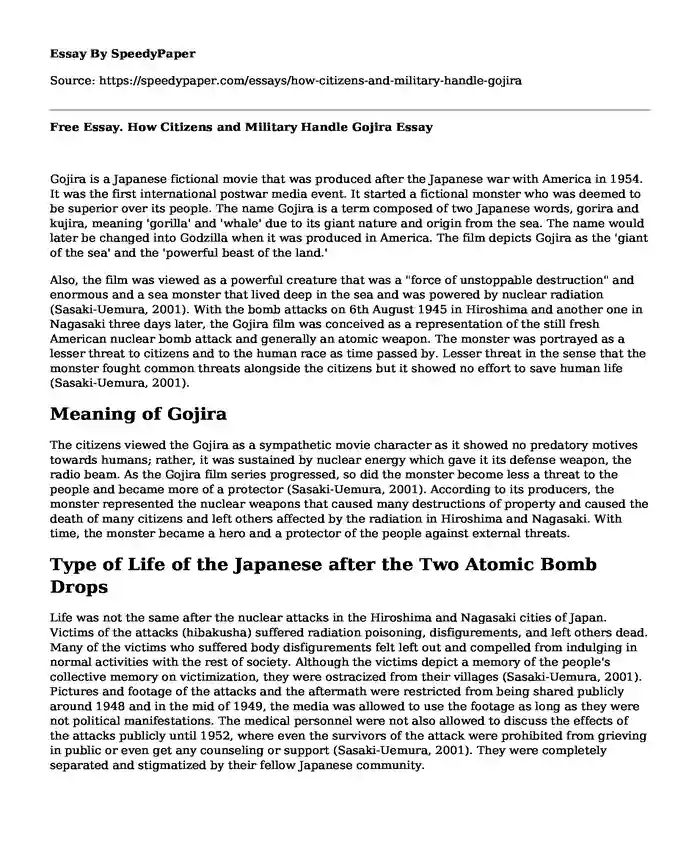Gojira is a Japanese fictional movie that was produced after the Japanese war with America in 1954. It was the first international postwar media event. It started a fictional monster who was deemed to be superior over its people. The name Gojira is a term composed of two Japanese words, gorira and kujira, meaning 'gorilla' and 'whale' due to its giant nature and origin from the sea. The name would later be changed into Godzilla when it was produced in America. The film depicts Gojira as the 'giant of the sea' and the 'powerful beast of the land.'
Also, the film was viewed as a powerful creature that was a "force of unstoppable destruction" and enormous and a sea monster that lived deep in the sea and was powered by nuclear radiation (Sasaki-Uemura, 2001). With the bomb attacks on 6th August 1945 in Hiroshima and another one in Nagasaki three days later, the Gojira film was conceived as a representation of the still fresh American nuclear bomb attack and generally an atomic weapon. The monster was portrayed as a lesser threat to citizens and to the human race as time passed by. Lesser threat in the sense that the monster fought common threats alongside the citizens but it showed no effort to save human life (Sasaki-Uemura, 2001).
Meaning of Gojira
The citizens viewed the Gojira as a sympathetic movie character as it showed no predatory motives towards humans; rather, it was sustained by nuclear energy which gave it its defense weapon, the radio beam. As the Gojira film series progressed, so did the monster become less a threat to the people and became more of a protector (Sasaki-Uemura, 2001). According to its producers, the monster represented the nuclear weapons that caused many destructions of property and caused the death of many citizens and left others affected by the radiation in Hiroshima and Nagasaki. With time, the monster became a hero and a protector of the people against external threats.
Type of Life of the Japanese after the Two Atomic Bomb Drops
Life was not the same after the nuclear attacks in the Hiroshima and Nagasaki cities of Japan. Victims of the attacks (hibakusha) suffered radiation poisoning, disfigurements, and left others dead. Many of the victims who suffered body disfigurements felt left out and compelled from indulging in normal activities with the rest of society. Although the victims depict a memory of the people's collective memory on victimization, they were ostracized from their villages (Sasaki-Uemura, 2001). Pictures and footage of the attacks and the aftermath were restricted from being shared publicly around 1948 and in the mid of 1949, the media was allowed to use the footage as long as they were not political manifestations. The medical personnel were not also allowed to discuss the effects of the attacks publicly until 1952, where even the survivors of the attack were prohibited from grieving in public or even get any counseling or support (Sasaki-Uemura, 2001). They were completely separated and stigmatized by their fellow Japanese community.
Signs of Honor and Unity by Citizens and Military
The Japanese community and the country at large did not show honor and unity for their country. Victims who did not even have visible marks did not want to share their experiences or conditions with others to avoid discrimination and rejection (Sasaki-Uemura, 2001). They found it hard to get involved in public matters such as political activities or joining peace movements on the victims.
Reference
Sasaki-Uemura, W. M. (2001). Organizing the Spontaneous: Citizens Protest in Postwar Japan. University of Hawaii Press. ISBN:0-8248-2439-3
Cite this page
Free Essay. How Citizens and Military Handle Gojira. (2023, Mar 29). Retrieved from https://speedypaper.net/essays/how-citizens-and-military-handle-gojira
Request Removal
If you are the original author of this essay and no longer wish to have it published on the SpeedyPaper website, please click below to request its removal:
- Education Essay Sample: Simple Way to Be a Good Student
- Free Essay on Determinants and Prevention of Maternal and Child Mortality
- Advantages of the Internet Essay Example
- Free Essay on Romantic Love in Shakespeare's Works
- Free Essay Sample on American Presidential Elections
- Paper Example: Analysis of 'The Metamorphosis'
- Essay Sample on Social Justice Movement in American History
Popular categories





